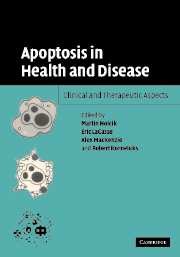Book contents
- Frontmatter
- Contents
- List of contributors
- Preface
- 1 Apoptosis in health, disease, and therapy: overview and methodology
- 2 Developmental apoptosis in health and disease
- 3 Apoptosis and cancer
- 4 Neuronal cell death in human neurodegenerative diseases and their animal/cell models
- 5 Apoptosis in the cardiovascular system: incidence, regulation, and therapeutic options
- 6 Cytotoxic lymphocytes, apoptosis, and autoimmunity
- 7 Pro- and anti-apoptotic strategies of viruses
- Index
- Plate section
Preface
Published online by Cambridge University Press: 03 March 2010
- Frontmatter
- Contents
- List of contributors
- Preface
- 1 Apoptosis in health, disease, and therapy: overview and methodology
- 2 Developmental apoptosis in health and disease
- 3 Apoptosis and cancer
- 4 Neuronal cell death in human neurodegenerative diseases and their animal/cell models
- 5 Apoptosis in the cardiovascular system: incidence, regulation, and therapeutic options
- 6 Cytotoxic lymphocytes, apoptosis, and autoimmunity
- 7 Pro- and anti-apoptotic strategies of viruses
- Index
- Plate section
Summary
Multicellular organisms are remarkable in their complexity, comprised of an almost unimaginably diverse array of molecular mechanisms enabling the propagation, differentiation, and maintenance of their component cells. But just as there exist precisely programmed mechanisms to generate and maintain the cellular constituents of metazoans, so too there exist elaborate means of ending the lives of cells. Homeostasis is achieved at the cost of a certain intolerance; cells have defined life spans, limited ability to deal with physical, chemical, electrical, thermal, or biologic stress, and a narrow scope of acceptable behavior, deviation from which rapidly results in death. Thus, cells which have served their purpose in development, have reached the end of their natural life span post-development, have sustained an injury, or in some way have become dysregulated conduct a rapid self-disassembly and then die efficiently, committing suicide. This programmed cell death or apoptosis is a natural ongoing process, necessary for life. As logical as this state of affairs may appear in hindsight, a full appreciation has only come over the last two decades.
Although, as might be expected, the number of molecular pathways enacting this cellular attrition pales in comparison with that required to generate a cell, they are nonetheless remarkably complex. The past decade has witnessed the delineation of many, and likely most, of the central molecular mechanisms and the constituent parts by which apoptosis occurs. This gratifying molecular progress leads directly to the question of therapeutic relevance.
- Type
- Chapter
- Information
- Apoptosis in Health and DiseaseClinical and Therapeutic Aspects, pp. ix - xPublisher: Cambridge University PressPrint publication year: 2005



